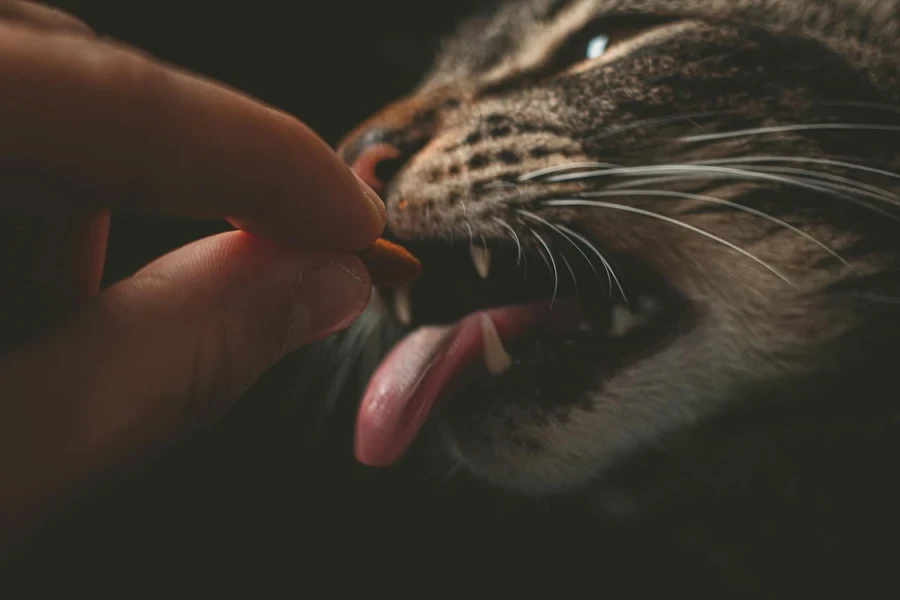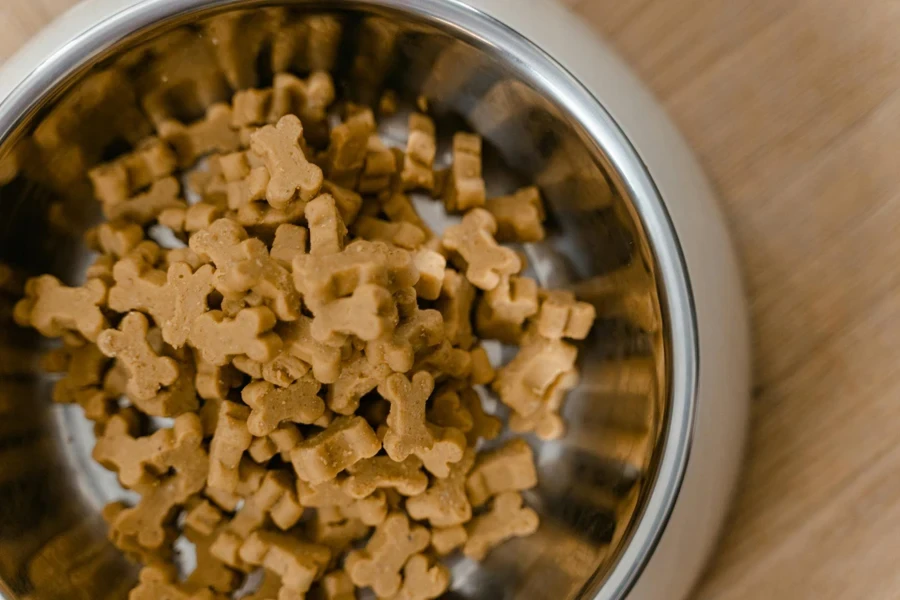Table of Contents
● Introduction
● Market overview
● Different types
● Key considerations for selecting the right pet food
● Conclusion
Introduction
The growing importance of pet nutrition is reshaping market trends and influencing pet owner preferences as more people recognise the critical role diet plays in their pets’ health and longevity. This shift has increased demand for high-quality, specialised pet foods catering to various life stages, lifestyles, and dietary needs. Pet owners are now more informed and selective, seeking products that provide optimal nutrition and support for specific health conditions. As a result, the pet food market is expanding with innovative offerings that address these evolving needs. This focus on nutrition underscores the commitment of both consumers and the industry to enhancing pet well-being through better dietary choices.

Market overview
The global pet food market is poised for significant expansion, with projections indicating an increase from $149.90 billion in 2024 to $186.10 billion by 2028, achieving a compound annual growth rate (CAGR) of 5.56% during this period, as reported by statista market insights. This growth is fueled mainly by pet humanisation, where pet owners increasingly invest in high-quality, nutritious products for their pets’ health and well-being. The demand for premium, natural ingredients and clean-label products, which exclude unwanted additives like heavy metals and contaminants, reflects a broader consumer preference for sustainability and wellness, enhancing market growth dynamics.
Regarding market share distribution, the United States remains a dominant force, contributing substantially to the global revenue in the pet food sector. Recent developments in the market include a shift towards alternative protein sources and superfoods, such as chia and kale, which cater to pets with specific dietary needs, including those with animal protein allergies. These innovations are critical as they align with the increasing consumer demand for specialised diets that promote overall pet health and are responsive to the evolving regulatory environment. As major players in the pet food industry continue to innovate and adapt, the market is expected to maintain its upward trajectory, meeting the sophisticated demands of health-conscious pet owners.

Different types
Dry pet food (Kibble)
Dry pet food, commonly called kibble, remains a cornerstone in the pet food industry due to its convenience, cost-effectiveness, and long shelf life. Its ease of storage and handling makes it an attractive option for retailers and distributors. Kibble’s formulation is designed to help reduce plaque build-up and promote dental health, a significant selling point for health-conscious pet owners. The nutrient density of high-quality dry food means that pets require smaller portions to meet their dietary needs, translating to economic benefits for consumers. For businesses, offering various kibble options— from basic formulations to premium, specialised diets—can cater to diverse customer preferences and pet needs, enhancing market appeal and driving sales.
Wet pet food
Wet pet food is a valuable addition to any product lineup, appealing to pet owners seeking high moisture content and palatable pet options. This food is particularly beneficial for hydration and is often preferred by pets with dental issues or those with a selective appetite. Its rich texture and flavour variety can enhance mealtime appeal, encouraging better food intake. For retailers, wet food offers an opportunity to cater to niche markets, including older pets, those with chewing difficulties, and pets needing increased water intake. Stocking a range of wet pet food options, from standard to premium formulations, can attract a broad customer base and meet the specific dietary preferences of discerning pet owners, ultimately boosting sales and customer satisfaction.
Snacks and treats
Snacks and treats are essential components of the pet food market, serving multiple purposes, from training aids to supplemental nutrition. These products provide significant opportunities for upselling and cross-selling, enhancing overall sales. Many treats are formulated with added health benefits, such as dental chews that help reduce tartar and plaque or treats enriched with vitamins, minerals, and supplements to support overall pet health. By offering a diverse range of snacks and treats, including natural, organic, and speciality options, businesses can cater to the growing demand for healthier and more functional pet products. This variety attracts health-conscious pet owners and encourages repeat purchases and brand loyalty, making snacks and treats a profitable addition to any pet food retail strategy.
Specialty pet foods
Specialty pet foods represent a rapidly growing segment in the pet food industry, designed to meet the unique dietary needs of pets with specific health conditions, allergies, or preferences. These products include grain-free, hypoallergenic, organic prescription diets tailored to address obesity, diabetes, kidney disease, and food sensitivities. For businesses, stocking speciality pet foods can significantly differentiate their offerings and attract a discerning customer base prioritising their pets’ health and well-being. By providing a range of high-quality, specialised options, retailers can cater to the increasing demand for personalised pet nutrition, driving customer loyalty and increasing sales in a competitive market.

Critical considerations for selecting the right pet food
Nutritional content requirements
When selecting pet food products, it is vital to consider the specific nutritional content requirements tailored to different types of pets. Dogs require a balanced diet with appropriate protein, fats, and carbohydrate levels, with protein being crucial for muscle development and repair. Cats, as obligate carnivores, need a higher protein intake, essential fats, and minimal carbohydrates to maintain optimal health. Conversely, rabbits need a diet high in fibre and low in fats and carbohydrates to support their digestive systems and overall well-being. Businesses must ensure that their product offerings meet these diverse dietary needs to provide optimal nutrition and promote the health and longevity of various pets.
Understanding pet food labels and ingredients
Understanding pet food labels and ingredients is critical for ensuring the quality and suitability of products offered to pet owners. Labels should clearly indicate the nutritional content, including protein, fat, and fibre percentages, along with a detailed list of ingredients. Prioritising products with high-quality ingredients, such as named meat sources and whole grains, over those with fillers, artificial additives, or by-products is essential. Transparency in ingredient sourcing and manufacturing processes enhances a brand’s reputation and builds consumer trust, meeting the growing demand for transparency among informed pet owners. By offering well-labelled products with premium ingredients, businesses can effectively cater to health-conscious consumers and establish a competitive edge in the pet food market.
Selecting pet food based on specific health concerns
Selecting pet food based on specific health concerns is crucial for addressing the unique needs of pets and enhancing their overall well-being. Pets with allergies often require grain-free or limited-ingredient diets to avoid common allergens like wheat, corn, and soy. For obese pets, weight management formulas lower in calories and higher in fibre are essential to help them achieve and maintain a healthy weight. Senior pets benefit from diets enriched with glucosamine, chondroitin, and antioxidants to support joint health and cognitive function. By offering specialised formulas that cater to these health concerns, businesses can meet the diverse needs of pet owners seeking targeted nutritional solutions, thereby improving customer satisfaction and loyalty while positioning themselves as leaders in the pet food industry.
Customer feedback and reviews
Customer feedback and reviews are invaluable for selecting and refining pet food products in the competitive market. Regularly monitoring and analysing feedback helps businesses understand consumer preferences, identify potential issues, and gauge the effectiveness of their products. Positive reviews can significantly enhance a product’s reputation and credibility, driving sales and customer loyalty. Conversely, constructive criticism provides insights into areas needing improvement, whether palatability, ingredient quality, or packaging. Engaging with customers through reviews builds trust and demonstrates a commitment to continuous improvement and customer satisfaction. By leveraging customer feedback, businesses can make informed decisions that align with market demands and enhance their product offerings, ensuring long-term success in the pet food industry.

Conclusion
Choosing the right pet food is pivotal for ensuring the health and well-being of pets, requiring a detailed understanding of the pet’s life stage, lifestyle, dietary needs, and food quality. As the pet food market expands, the availability of specialised products designed to cater to unique requirements allows businesses to serve a diverse clientele effectively. This selection process, which includes focusing on high-quality ingredients and reputable brands, enhances pet health and bolsters business credibility and success in a competitive market. Thus, businesses can build strong customer trust and satisfaction by providing tailored nutrition solutions that address pets’ specific health and lifestyle needs.




